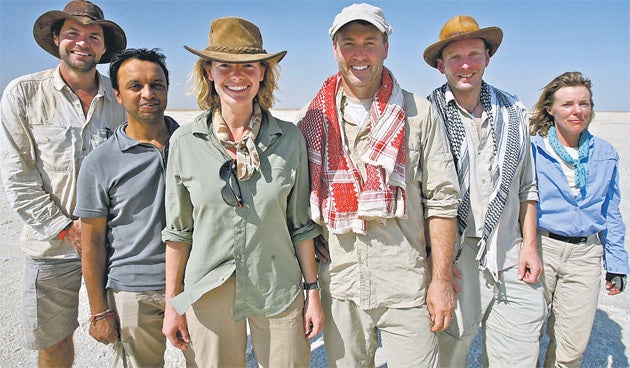Last Night's Television: Raising the temperature
The Hottest Place on Earth, BBC1<br />Red Riding, Channel 4

So we're not freezing any more. The snow has melted, and the crocuses are starting to bloom. Summer, anyone? Ha, don't even think about it. Even if the sun does begin to peep out from behind the clouds, our temperatures are positively feeble compared with the rest of the world. And just in case you'd forgotten, here comes a new television series to remind you: BBC1's two-parter The Hottest Place on Earth.
It takes place in Ethiopia's Danakil desert, where temperatures are in the forties, day and night. That's proper heat: proper, scalding, ocean-evaporating heat, with little pools of lava and everything. The BBC sent a team of English folk out to see how they coped. Result? Lots of moaning and groaning, and loads of those end-of-the-world-style warnings about how much they're risking, blah blah blah, but, actually, quite a lot of good stuff, too.
"It seems absurd that people would live here!" remarked Kate Humble, our host for the series. Presumably, the Danakil-dwellers think the same about us. Kate's pretty together, but she did have a touch of the English auntie about her. Every now and then, her plummy voice would ring out with something seriously cringe-making. "They say that dancing here is just for men, but NOTHING's going to keep me off that dance floor tonight!" What dance floor? It's a group of tribesmen hopping in the sand. Oh, no, too late: four tribesmen and a sunburned Brit, leaping up and down for all she was worth. "Gosh, I've pulled! And I've only been here five minutes!"
But it wasn't just Kate on the tour. There was a geologist called Dougal, as well as Mukul, a doctor, and, mysteriously, Steve, an "animal expert". "I actually have some fresh camel urine here," Steve babbled at one point, waving a beaker of yellow liquid. "Mm! It's salty!" Their first stop on the tour was a local salt mine. This was sort of incredible for several reasons. Firstly, the heat. It's so hot that when, in the 1960s, some Americans tried to set up a mining company, none of the machines worked. Instead, the mines are staffed by locals, who don't even break a sweat.
It was also incredible because it looked like something out of the Bible. Well, kind of: there were lots of camels and donkeys and plenty of linen-clad miners, but also hundreds of pairs of wraparound sunglasses. Virtually everyone seemed to be wearing Oakleys. Where did they all come from? Sadly, no one asked. But they did do a neat little trick, making Kate and Steve swallow thermometers. After 15 minutes' mining, they registered dangerously high changes in temperature. The locals? Nothing. Amazing!
From the mine, they headed to the Erta Ale volcano, which looked like something out of The Wizard of Oz: patches of rainbow red, green and blue, totally magical, with bubbling pools of acid in-between. We left them at a local village, just as things were getting really fun. Yes, there were the hopping tribesmen, but there was also a choice little exchange between the team biologist and the local chief. The chief was called Galissa, which means "frightening" in English. "He doesn't look very frightening," chuckled the gung-ho biologist. "It's only the first morning," shot back Frightening, deadpan as you like. Kate, meanwhile, was getting huffy because the women did all the work, while the men just sat around drinking tea. It did seem a bit unfair, if not that different from life as I know it, and Kate was bent on revolution. Will she succeed? Well, that's next week's story.
In the meantime, there was the final part of Red Riding to keep us going. Of course, by the end, so much of what initially made the series appealing had lost its novelty: all that macho smoking, pint-drinking and spontaneous sex. But the drama was still there, as was the acting, this time courtesy of Mark Addy as the takeaway-scoffing, good-guy solicitor John Piggott.
Bearing the mark of yet another director (this time, Anand Tucker), it was, almost, a cross between the first and the second episode, less confusing than 1974, but rather darker than 1980. This time, it was 1983, nine years after Detective Jobson and co (but mainly co) framed a local boy for a set of schoolgirl murders. With a new girl gone missing, Jobson was experiencing a touch of the guilts, something that was only fuelled by an unlikely visit to a psychic, who thought the girl was still alive, waiting to be saved. While Jobson chewed on his conscience, Piggott got a call from the framed man's mum, pleading for him to help. Initial reluctance gave way to passionate engagement, and he decided to take the case on.
Thus began the final chapter in this parable of Northern discontent. It was, as before, completely compelling, not-to-be-missed TV. That said, I was in some ways rather glad to see the back of it. After all, there are only so many Thursday nights you can devote to relentless gloom-mongering.
a.jarvis@independent.co.uk
Join our commenting forum
Join thought-provoking conversations, follow other Independent readers and see their replies
Comments